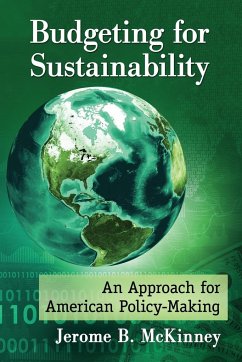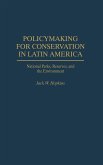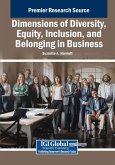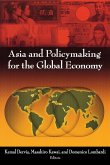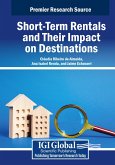- Broschiertes Buch
- Merkliste
- Auf die Merkliste
- Bewerten Bewerten
- Teilen
- Produkt teilen
- Produkterinnerung
- Produkterinnerung
This book provides critical insights about how U.S. policymaking is likely to be imperiling America's future, and how only the most efficient and productive organizations and governments will reap globalization's greatest rewards. Vital areas such as vocational training, manufacturing, infrastructure, sustainable debt creation and the STEM worker shortage crisis are extensively examined and innovative solutions are proposed. Twenty-seven common-good indicators are presented for assessing policymaking, aimed at providing maximum transparency and accountability.
Andere Kunden interessierten sich auch für
![Policymaking for Conservation in Latin America Policymaking for Conservation in Latin America]() Jack W. HopkinsPolicymaking for Conservation in Latin America101,99 €
Jack W. HopkinsPolicymaking for Conservation in Latin America101,99 €![Dimensions of Diversity, Equity, Inclusion, and Belonging in Business Dimensions of Diversity, Equity, Inclusion, and Belonging in Business]() Dimensions of Diversity, Equity, Inclusion, and Belonging in Business210,99 €
Dimensions of Diversity, Equity, Inclusion, and Belonging in Business210,99 €![Asia and Policymaking for the Global Economy Asia and Policymaking for the Global Economy]() Asia and Policymaking for the Global Economy34,99 €
Asia and Policymaking for the Global Economy34,99 €![Crisis Policymaking in the EU Crisis Policymaking in the EU]() Hanspeter KriesiCrisis Policymaking in the EU25,99 €
Hanspeter KriesiCrisis Policymaking in the EU25,99 €![The Structure and Dynamics of U.S. Government Policymaking The Structure and Dynamics of U.S. Government Policymaking]() Ewan AndersonThe Structure and Dynamics of U.S. Government Policymaking101,99 €
Ewan AndersonThe Structure and Dynamics of U.S. Government Policymaking101,99 €![Economics and Policymaking Economics and Policymaking]() Eugene J. MeehanEconomics and Policymaking80,99 €
Eugene J. MeehanEconomics and Policymaking80,99 €![Short-Term Rentals and Their Impact on Destinations Short-Term Rentals and Their Impact on Destinations]() Short-Term Rentals and Their Impact on Destinations252,99 €
Short-Term Rentals and Their Impact on Destinations252,99 €-
-
-
This book provides critical insights about how U.S. policymaking is likely to be imperiling America's future, and how only the most efficient and productive organizations and governments will reap globalization's greatest rewards. Vital areas such as vocational training, manufacturing, infrastructure, sustainable debt creation and the STEM worker shortage crisis are extensively examined and innovative solutions are proposed. Twenty-seven common-good indicators are presented for assessing policymaking, aimed at providing maximum transparency and accountability.
Hinweis: Dieser Artikel kann nur an eine deutsche Lieferadresse ausgeliefert werden.
Hinweis: Dieser Artikel kann nur an eine deutsche Lieferadresse ausgeliefert werden.
Produktdetails
- Produktdetails
- Verlag: McFarland
- Seitenzahl: 248
- Erscheinungstermin: 1. November 2017
- Englisch
- Abmessung: 229mm x 152mm x 15mm
- Gewicht: 408g
- ISBN-13: 9781476668703
- ISBN-10: 1476668701
- Artikelnr.: 48030558
- Herstellerkennzeichnung
- Libri GmbH
- Europaallee 1
- 36244 Bad Hersfeld
- gpsr@libri.de
- Verlag: McFarland
- Seitenzahl: 248
- Erscheinungstermin: 1. November 2017
- Englisch
- Abmessung: 229mm x 152mm x 15mm
- Gewicht: 408g
- ISBN-13: 9781476668703
- ISBN-10: 1476668701
- Artikelnr.: 48030558
- Herstellerkennzeichnung
- Libri GmbH
- Europaallee 1
- 36244 Bad Hersfeld
- gpsr@libri.de
Jerome B. McKinney is a professor of public policy and management at the Graduate School of Public and International Affairs, University of Pittsburgh. He has consulted at the international, national, state and local levels of government.
Table of Contents Acknowledgments Preface 1.
America's Vulnerability: A Reality Check The Guiding Pursuit 11; Environmental Performance and Infrastructure Ranking 12; Globalization and the Sustainability Imperative 13; Defining Sustainability 13; Attributes of Sustainable Companies 15; The Innovation Imperative 16; Sustainable Competitiveness Among Nations 17; Math, Science, Reading and Engineering 21; U.S. STEM Programs: Foreign Student Dependence 22; Research and Development Expenditures 22; STEM Area for Action and Leadership 23; High Technology Exports 26; Quality of Higher Education 26; Patents and Manufacturing 27; Ease of Doing Business 28; Tax and Environmental Sustainability 29; Ramifications of the Great Recession on Sustainability 31; Retooling the U.S. Economic Engine 2.
The Sustainability Budget Model The State of Budget Making in the U.S. 35; Sustainability Budgeting: An Early Attempt 36; Green Sustainability Budget 37; Green Budgets vs. Fiscal Sustainability Budgets 38; Fiscal Models of Sustainability Analysis 40; Sustainability Budgeting and Public Finance 41; Instant Transparency and Accountability 3.
Comparing Critical Selected Indicators Income Inequality 52; Life Expectancy 53; High Tech Exports 55; Total Corporate Tax Rate 55; Sustainability in Industrializing and Industrial Economies 56; Selected Indicators: Industrializing and Industrialized Countries 57; Competitiveness 59; OECD Better Life Initiative 4.
Infrastructure and Sustainability Budgeting Hard and Soft Infrastructure 66; U.S. Infrastructure: Implications for Competitiveness 67; Four Opinions on U.S. Infrastructure Competitiveness 69; Transportation Infrastructure Report, 2012 73; World Infrastructure Rankings 5.
The Training Imperative and Sustainability Importance of Training 84; Sustainability Budgeting and Training 84; The German Training Model 86; Vocational Education in Finland: Preparation for the Global Economy 88; Singapore: Sustainable Training for Competitiveness 89; Training in the European Union (EU) 91; Business and Union Unity on Training 92; EU Impact of Education and Training in Ireland 93; Lifelong Learning in the EU 94; Training and Inclusiveness 95; European Union: Linking Inclusiveness to Sustainability 97; China and Vocational Education 98; Capable U.S. Workforce 99; U.S. Education and the Job Market 102; Closing the Skills Gap 103; U.S. Vocational Education Training 104; Apprenticeship: Some Perspectives 108; The Critical Need: A Training Development Bank 110; The U.S. Training and Development Bank 6.
Manufacturing and the Sustainability Imperative Importance of Manufacturing 115; Manufacturing Competitiveness 117; International Competitiveness 118; Drivers of Global Manufacturing Competitiveness 119; U.S. Rating on the Global Manufacturing Index 119; Consistent Characteristics of Competitive Manufacturing 120; America's Manufacturing Renaissance 121; U.S. Companies Reshoring: The Extent of It 123; Sustainability and Manufacturing 125; Impact of Public Policy on Competitiveness 127; Tax Policy as an Instrument for Revitalizing U.S. Manufacturing 130; A National Manufacturing Strategy 131; Sustainability Challenges 7.
Sustainability Budgeting and Multinational deleteCompanies What Is a Multinational Company (MNC)? 137; Roles MNCs 137; Multinational Guiding Philosophy 138; Selected MNC Philosophy/Guidelines 139; Corporate Social Responsibility (CSR) 140; MNCs' Operating Perspectives vs. Home Country 142; Sources of Conflict Between MNCs and Host Country 143; Ways MNCs Can Influence Host Countries 144; MNCs and Foreign Policy 144; Multinationals and the U.S. Economy 145; Multinationals' Pay and Working Conditions 145; Multinationals and Sustainability 146; Sustainability and MNCs Battle for Talent 148; Six Developing Trends in Sustainability 150; Sustainability and Innovation 8.
Sustainability Budgeting and Debt Creation Nature and Magnitude of U.S. Debt 158; Advantages of Deficit Spending 161; Owners of the U.S. Public Debt 161; Rising Government Debt: Public Policy by Default 163; Intentional Incurrence of Deficit 164; Debt Limitation as a Political and Backdoor Partial Check 164; California's Proposition 13 Legacy and the Drivers for Debt Creation 166; What Is Proposition 13? 167; Delinking Spending and Revenue Requirements 168; Debt Creation as the Imperative for Prosperity 169; Federal Capital Budgeting 171; Pros on Federal Capital Budgeting 172; Cons on Federal Capital Budgeting 174; Array of Forces against a Federal Capital Budget 175; Concerns About Adopting a Capital Budget 177; Debt Creation and Sustainability 178; Debt Sustainability Assessment 178; Defining Fiscal Debt Sustainability 179; Fiscal Sustainability Report 180; EU Sustainability Debt Pact 181; Achieving Sustainable Debt Targets in OECD Countries: Empirical Findings 182; Debt Creation and Crowding Out Effects 183; Some Types of Crowding Out 184; Debt Burden 186; Quality Public Debt and Sustainability 187; Actual versus Real Deficit 187; When Public Debt Is Good 188; When Public Debt Is Bad 189; The Simpson-Bowles Plan 190; Deleveraging: Post-Great Recession 192; Concluding Observations Summary and Concluding Observations The Education Conundrum 198; Training Imperative Recommendations 199; The Need for a Training Development Bank 200; Infrastructure Status and Recommendations Chapter Notes Bibliography Index
America's Vulnerability: A Reality Check The Guiding Pursuit 11; Environmental Performance and Infrastructure Ranking 12; Globalization and the Sustainability Imperative 13; Defining Sustainability 13; Attributes of Sustainable Companies 15; The Innovation Imperative 16; Sustainable Competitiveness Among Nations 17; Math, Science, Reading and Engineering 21; U.S. STEM Programs: Foreign Student Dependence 22; Research and Development Expenditures 22; STEM Area for Action and Leadership 23; High Technology Exports 26; Quality of Higher Education 26; Patents and Manufacturing 27; Ease of Doing Business 28; Tax and Environmental Sustainability 29; Ramifications of the Great Recession on Sustainability 31; Retooling the U.S. Economic Engine 2.
The Sustainability Budget Model The State of Budget Making in the U.S. 35; Sustainability Budgeting: An Early Attempt 36; Green Sustainability Budget 37; Green Budgets vs. Fiscal Sustainability Budgets 38; Fiscal Models of Sustainability Analysis 40; Sustainability Budgeting and Public Finance 41; Instant Transparency and Accountability 3.
Comparing Critical Selected Indicators Income Inequality 52; Life Expectancy 53; High Tech Exports 55; Total Corporate Tax Rate 55; Sustainability in Industrializing and Industrial Economies 56; Selected Indicators: Industrializing and Industrialized Countries 57; Competitiveness 59; OECD Better Life Initiative 4.
Infrastructure and Sustainability Budgeting Hard and Soft Infrastructure 66; U.S. Infrastructure: Implications for Competitiveness 67; Four Opinions on U.S. Infrastructure Competitiveness 69; Transportation Infrastructure Report, 2012 73; World Infrastructure Rankings 5.
The Training Imperative and Sustainability Importance of Training 84; Sustainability Budgeting and Training 84; The German Training Model 86; Vocational Education in Finland: Preparation for the Global Economy 88; Singapore: Sustainable Training for Competitiveness 89; Training in the European Union (EU) 91; Business and Union Unity on Training 92; EU Impact of Education and Training in Ireland 93; Lifelong Learning in the EU 94; Training and Inclusiveness 95; European Union: Linking Inclusiveness to Sustainability 97; China and Vocational Education 98; Capable U.S. Workforce 99; U.S. Education and the Job Market 102; Closing the Skills Gap 103; U.S. Vocational Education Training 104; Apprenticeship: Some Perspectives 108; The Critical Need: A Training Development Bank 110; The U.S. Training and Development Bank 6.
Manufacturing and the Sustainability Imperative Importance of Manufacturing 115; Manufacturing Competitiveness 117; International Competitiveness 118; Drivers of Global Manufacturing Competitiveness 119; U.S. Rating on the Global Manufacturing Index 119; Consistent Characteristics of Competitive Manufacturing 120; America's Manufacturing Renaissance 121; U.S. Companies Reshoring: The Extent of It 123; Sustainability and Manufacturing 125; Impact of Public Policy on Competitiveness 127; Tax Policy as an Instrument for Revitalizing U.S. Manufacturing 130; A National Manufacturing Strategy 131; Sustainability Challenges 7.
Sustainability Budgeting and Multinational deleteCompanies What Is a Multinational Company (MNC)? 137; Roles MNCs 137; Multinational Guiding Philosophy 138; Selected MNC Philosophy/Guidelines 139; Corporate Social Responsibility (CSR) 140; MNCs' Operating Perspectives vs. Home Country 142; Sources of Conflict Between MNCs and Host Country 143; Ways MNCs Can Influence Host Countries 144; MNCs and Foreign Policy 144; Multinationals and the U.S. Economy 145; Multinationals' Pay and Working Conditions 145; Multinationals and Sustainability 146; Sustainability and MNCs Battle for Talent 148; Six Developing Trends in Sustainability 150; Sustainability and Innovation 8.
Sustainability Budgeting and Debt Creation Nature and Magnitude of U.S. Debt 158; Advantages of Deficit Spending 161; Owners of the U.S. Public Debt 161; Rising Government Debt: Public Policy by Default 163; Intentional Incurrence of Deficit 164; Debt Limitation as a Political and Backdoor Partial Check 164; California's Proposition 13 Legacy and the Drivers for Debt Creation 166; What Is Proposition 13? 167; Delinking Spending and Revenue Requirements 168; Debt Creation as the Imperative for Prosperity 169; Federal Capital Budgeting 171; Pros on Federal Capital Budgeting 172; Cons on Federal Capital Budgeting 174; Array of Forces against a Federal Capital Budget 175; Concerns About Adopting a Capital Budget 177; Debt Creation and Sustainability 178; Debt Sustainability Assessment 178; Defining Fiscal Debt Sustainability 179; Fiscal Sustainability Report 180; EU Sustainability Debt Pact 181; Achieving Sustainable Debt Targets in OECD Countries: Empirical Findings 182; Debt Creation and Crowding Out Effects 183; Some Types of Crowding Out 184; Debt Burden 186; Quality Public Debt and Sustainability 187; Actual versus Real Deficit 187; When Public Debt Is Good 188; When Public Debt Is Bad 189; The Simpson-Bowles Plan 190; Deleveraging: Post-Great Recession 192; Concluding Observations Summary and Concluding Observations The Education Conundrum 198; Training Imperative Recommendations 199; The Need for a Training Development Bank 200; Infrastructure Status and Recommendations Chapter Notes Bibliography Index
Table of Contents Acknowledgments Preface 1.
America's Vulnerability: A Reality Check The Guiding Pursuit 11; Environmental Performance and Infrastructure Ranking 12; Globalization and the Sustainability Imperative 13; Defining Sustainability 13; Attributes of Sustainable Companies 15; The Innovation Imperative 16; Sustainable Competitiveness Among Nations 17; Math, Science, Reading and Engineering 21; U.S. STEM Programs: Foreign Student Dependence 22; Research and Development Expenditures 22; STEM Area for Action and Leadership 23; High Technology Exports 26; Quality of Higher Education 26; Patents and Manufacturing 27; Ease of Doing Business 28; Tax and Environmental Sustainability 29; Ramifications of the Great Recession on Sustainability 31; Retooling the U.S. Economic Engine 2.
The Sustainability Budget Model The State of Budget Making in the U.S. 35; Sustainability Budgeting: An Early Attempt 36; Green Sustainability Budget 37; Green Budgets vs. Fiscal Sustainability Budgets 38; Fiscal Models of Sustainability Analysis 40; Sustainability Budgeting and Public Finance 41; Instant Transparency and Accountability 3.
Comparing Critical Selected Indicators Income Inequality 52; Life Expectancy 53; High Tech Exports 55; Total Corporate Tax Rate 55; Sustainability in Industrializing and Industrial Economies 56; Selected Indicators: Industrializing and Industrialized Countries 57; Competitiveness 59; OECD Better Life Initiative 4.
Infrastructure and Sustainability Budgeting Hard and Soft Infrastructure 66; U.S. Infrastructure: Implications for Competitiveness 67; Four Opinions on U.S. Infrastructure Competitiveness 69; Transportation Infrastructure Report, 2012 73; World Infrastructure Rankings 5.
The Training Imperative and Sustainability Importance of Training 84; Sustainability Budgeting and Training 84; The German Training Model 86; Vocational Education in Finland: Preparation for the Global Economy 88; Singapore: Sustainable Training for Competitiveness 89; Training in the European Union (EU) 91; Business and Union Unity on Training 92; EU Impact of Education and Training in Ireland 93; Lifelong Learning in the EU 94; Training and Inclusiveness 95; European Union: Linking Inclusiveness to Sustainability 97; China and Vocational Education 98; Capable U.S. Workforce 99; U.S. Education and the Job Market 102; Closing the Skills Gap 103; U.S. Vocational Education Training 104; Apprenticeship: Some Perspectives 108; The Critical Need: A Training Development Bank 110; The U.S. Training and Development Bank 6.
Manufacturing and the Sustainability Imperative Importance of Manufacturing 115; Manufacturing Competitiveness 117; International Competitiveness 118; Drivers of Global Manufacturing Competitiveness 119; U.S. Rating on the Global Manufacturing Index 119; Consistent Characteristics of Competitive Manufacturing 120; America's Manufacturing Renaissance 121; U.S. Companies Reshoring: The Extent of It 123; Sustainability and Manufacturing 125; Impact of Public Policy on Competitiveness 127; Tax Policy as an Instrument for Revitalizing U.S. Manufacturing 130; A National Manufacturing Strategy 131; Sustainability Challenges 7.
Sustainability Budgeting and Multinational deleteCompanies What Is a Multinational Company (MNC)? 137; Roles MNCs 137; Multinational Guiding Philosophy 138; Selected MNC Philosophy/Guidelines 139; Corporate Social Responsibility (CSR) 140; MNCs' Operating Perspectives vs. Home Country 142; Sources of Conflict Between MNCs and Host Country 143; Ways MNCs Can Influence Host Countries 144; MNCs and Foreign Policy 144; Multinationals and the U.S. Economy 145; Multinationals' Pay and Working Conditions 145; Multinationals and Sustainability 146; Sustainability and MNCs Battle for Talent 148; Six Developing Trends in Sustainability 150; Sustainability and Innovation 8.
Sustainability Budgeting and Debt Creation Nature and Magnitude of U.S. Debt 158; Advantages of Deficit Spending 161; Owners of the U.S. Public Debt 161; Rising Government Debt: Public Policy by Default 163; Intentional Incurrence of Deficit 164; Debt Limitation as a Political and Backdoor Partial Check 164; California's Proposition 13 Legacy and the Drivers for Debt Creation 166; What Is Proposition 13? 167; Delinking Spending and Revenue Requirements 168; Debt Creation as the Imperative for Prosperity 169; Federal Capital Budgeting 171; Pros on Federal Capital Budgeting 172; Cons on Federal Capital Budgeting 174; Array of Forces against a Federal Capital Budget 175; Concerns About Adopting a Capital Budget 177; Debt Creation and Sustainability 178; Debt Sustainability Assessment 178; Defining Fiscal Debt Sustainability 179; Fiscal Sustainability Report 180; EU Sustainability Debt Pact 181; Achieving Sustainable Debt Targets in OECD Countries: Empirical Findings 182; Debt Creation and Crowding Out Effects 183; Some Types of Crowding Out 184; Debt Burden 186; Quality Public Debt and Sustainability 187; Actual versus Real Deficit 187; When Public Debt Is Good 188; When Public Debt Is Bad 189; The Simpson-Bowles Plan 190; Deleveraging: Post-Great Recession 192; Concluding Observations Summary and Concluding Observations The Education Conundrum 198; Training Imperative Recommendations 199; The Need for a Training Development Bank 200; Infrastructure Status and Recommendations Chapter Notes Bibliography Index
America's Vulnerability: A Reality Check The Guiding Pursuit 11; Environmental Performance and Infrastructure Ranking 12; Globalization and the Sustainability Imperative 13; Defining Sustainability 13; Attributes of Sustainable Companies 15; The Innovation Imperative 16; Sustainable Competitiveness Among Nations 17; Math, Science, Reading and Engineering 21; U.S. STEM Programs: Foreign Student Dependence 22; Research and Development Expenditures 22; STEM Area for Action and Leadership 23; High Technology Exports 26; Quality of Higher Education 26; Patents and Manufacturing 27; Ease of Doing Business 28; Tax and Environmental Sustainability 29; Ramifications of the Great Recession on Sustainability 31; Retooling the U.S. Economic Engine 2.
The Sustainability Budget Model The State of Budget Making in the U.S. 35; Sustainability Budgeting: An Early Attempt 36; Green Sustainability Budget 37; Green Budgets vs. Fiscal Sustainability Budgets 38; Fiscal Models of Sustainability Analysis 40; Sustainability Budgeting and Public Finance 41; Instant Transparency and Accountability 3.
Comparing Critical Selected Indicators Income Inequality 52; Life Expectancy 53; High Tech Exports 55; Total Corporate Tax Rate 55; Sustainability in Industrializing and Industrial Economies 56; Selected Indicators: Industrializing and Industrialized Countries 57; Competitiveness 59; OECD Better Life Initiative 4.
Infrastructure and Sustainability Budgeting Hard and Soft Infrastructure 66; U.S. Infrastructure: Implications for Competitiveness 67; Four Opinions on U.S. Infrastructure Competitiveness 69; Transportation Infrastructure Report, 2012 73; World Infrastructure Rankings 5.
The Training Imperative and Sustainability Importance of Training 84; Sustainability Budgeting and Training 84; The German Training Model 86; Vocational Education in Finland: Preparation for the Global Economy 88; Singapore: Sustainable Training for Competitiveness 89; Training in the European Union (EU) 91; Business and Union Unity on Training 92; EU Impact of Education and Training in Ireland 93; Lifelong Learning in the EU 94; Training and Inclusiveness 95; European Union: Linking Inclusiveness to Sustainability 97; China and Vocational Education 98; Capable U.S. Workforce 99; U.S. Education and the Job Market 102; Closing the Skills Gap 103; U.S. Vocational Education Training 104; Apprenticeship: Some Perspectives 108; The Critical Need: A Training Development Bank 110; The U.S. Training and Development Bank 6.
Manufacturing and the Sustainability Imperative Importance of Manufacturing 115; Manufacturing Competitiveness 117; International Competitiveness 118; Drivers of Global Manufacturing Competitiveness 119; U.S. Rating on the Global Manufacturing Index 119; Consistent Characteristics of Competitive Manufacturing 120; America's Manufacturing Renaissance 121; U.S. Companies Reshoring: The Extent of It 123; Sustainability and Manufacturing 125; Impact of Public Policy on Competitiveness 127; Tax Policy as an Instrument for Revitalizing U.S. Manufacturing 130; A National Manufacturing Strategy 131; Sustainability Challenges 7.
Sustainability Budgeting and Multinational deleteCompanies What Is a Multinational Company (MNC)? 137; Roles MNCs 137; Multinational Guiding Philosophy 138; Selected MNC Philosophy/Guidelines 139; Corporate Social Responsibility (CSR) 140; MNCs' Operating Perspectives vs. Home Country 142; Sources of Conflict Between MNCs and Host Country 143; Ways MNCs Can Influence Host Countries 144; MNCs and Foreign Policy 144; Multinationals and the U.S. Economy 145; Multinationals' Pay and Working Conditions 145; Multinationals and Sustainability 146; Sustainability and MNCs Battle for Talent 148; Six Developing Trends in Sustainability 150; Sustainability and Innovation 8.
Sustainability Budgeting and Debt Creation Nature and Magnitude of U.S. Debt 158; Advantages of Deficit Spending 161; Owners of the U.S. Public Debt 161; Rising Government Debt: Public Policy by Default 163; Intentional Incurrence of Deficit 164; Debt Limitation as a Political and Backdoor Partial Check 164; California's Proposition 13 Legacy and the Drivers for Debt Creation 166; What Is Proposition 13? 167; Delinking Spending and Revenue Requirements 168; Debt Creation as the Imperative for Prosperity 169; Federal Capital Budgeting 171; Pros on Federal Capital Budgeting 172; Cons on Federal Capital Budgeting 174; Array of Forces against a Federal Capital Budget 175; Concerns About Adopting a Capital Budget 177; Debt Creation and Sustainability 178; Debt Sustainability Assessment 178; Defining Fiscal Debt Sustainability 179; Fiscal Sustainability Report 180; EU Sustainability Debt Pact 181; Achieving Sustainable Debt Targets in OECD Countries: Empirical Findings 182; Debt Creation and Crowding Out Effects 183; Some Types of Crowding Out 184; Debt Burden 186; Quality Public Debt and Sustainability 187; Actual versus Real Deficit 187; When Public Debt Is Good 188; When Public Debt Is Bad 189; The Simpson-Bowles Plan 190; Deleveraging: Post-Great Recession 192; Concluding Observations Summary and Concluding Observations The Education Conundrum 198; Training Imperative Recommendations 199; The Need for a Training Development Bank 200; Infrastructure Status and Recommendations Chapter Notes Bibliography Index

